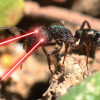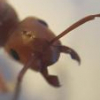- Formiculture.com
- Forums
- Gallery
- Members
- Member Map
- Chat

Queen ant ID please
Started By
Alacom
, May 2 2019 3:56 PM
16 replies to this topic
#1
 Offline
-
Posted May 2 2019 - 3:56 PM
Offline
-
Posted May 2 2019 - 3:56 PM
I caught this Queen in California right in my backyard. It was on April 26, and there had been a light right 6 days prior. I think it’s a camponotus pennsylvanicus Queen, and she already laid eggs. Sorry for the bad pics.
https://imgur.com/gallery/EHZGVkA
https://imgur.com/gallery/EHZGVkA
#2
 Offline
-
Posted May 2 2019 - 4:12 PM
Offline
-
Posted May 2 2019 - 4:12 PM
You is probably correct.
#3
 Offline
-
Posted May 2 2019 - 5:38 PM
Offline
-
Posted May 2 2019 - 5:38 PM
I would say its not a camponotus pennsylvanicus. It is definitely some kind of formica, judging by the queens red legs.
#5
 Offline
-
Posted May 2 2019 - 6:24 PM
Offline
-
Posted May 2 2019 - 6:24 PM
Please read the ant ID template and fill in the missing information so we can help get a positive ID. That doesn't look like C. pennsylvanicus. though, at least in those pics.
Edited by Jamiesname, May 2 2019 - 6:26 PM.
#6
 Offline
-
Posted May 2 2019 - 6:31 PM
Offline
-
Posted May 2 2019 - 6:31 PM
I'd say Camponotus modoc.
It looks a lot like one, but something about the thorax looks a bit different on the two.
#7
 Offline
-
Posted May 2 2019 - 6:55 PM
Offline
-
Posted May 2 2019 - 6:55 PM
I tried to be more specific in the details and tried to take a better picture (but it’s trash)
1. Location (on a map) of collection: Modesto, California
2. Date of collection: April 26th, 2019
3. Habitat of collection: Suburbs
4. Length (from head to gaster ): Pretty much exactly 1cm
5. Color, hue, pattern and texture: Dark brown with reddish-brown legs.
6. Distinguishing characteristics: I don’t think her antennae are long enough to be Formica, and her thorax looks a bit different than that of Camponotus. modoc.
7. Distinguishing behavior: Stays relatively calm when disturbed.
8. Nest description: (See picture)
9. Nuptial flight time and date: I’m not sure about the exact nuptial flight date for the mass of her species, as I didn’t see any other queens. I assume that it was either the end of a nuptial flight or it was a mini one. I caught her at around 9pm.
https://imgur.com/gallery/mHw2ee5
1. Location (on a map) of collection: Modesto, California
2. Date of collection: April 26th, 2019
3. Habitat of collection: Suburbs
4. Length (from head to gaster ): Pretty much exactly 1cm
5. Color, hue, pattern and texture: Dark brown with reddish-brown legs.
6. Distinguishing characteristics: I don’t think her antennae are long enough to be Formica, and her thorax looks a bit different than that of Camponotus. modoc.
7. Distinguishing behavior: Stays relatively calm when disturbed.
8. Nest description: (See picture)
9. Nuptial flight time and date: I’m not sure about the exact nuptial flight date for the mass of her species, as I didn’t see any other queens. I assume that it was either the end of a nuptial flight or it was a mini one. I caught her at around 9pm.
https://imgur.com/gallery/mHw2ee5
#8
 Offline
-
Posted May 2 2019 - 7:33 PM
Offline
-
Posted May 2 2019 - 7:33 PM
Ten mm is too small to be C. modoc or C. pennsylvanicus.
- rbarreto likes this
Instagram:
nurbsants
YouTube
California Ants for Sale
Unidentified Myrmecocystus
https://www.formicul...ls-near-desert/
Undescribed "Modoc"
https://www.formicul...mp-ca-5-4-2017/
Camponotus or Colobopsis yogi:
https://www.formicul...a-ca-1-28-2018/
Camponotus us-ca02
https://www.formicul...onotus-us-ca02/
Unidentified Formica
https://www.formicul...l-ca-6-27-2020/
Pencil Case and Test Tube Formicariums
https://www.formicul...m-and-outworld/
Bloodworm Soup
https://www.formicul...bloodworm-soup/
#9
 Offline
-
Posted May 2 2019 - 7:33 PM
Offline
-
Posted May 2 2019 - 7:33 PM
This is not a Camponotus queen this is a Liometopum occidentale queen.
- nurbs likes this
Plants r cool
#10
 Offline
-
Posted May 2 2019 - 7:47 PM
Offline
-
Posted May 2 2019 - 7:47 PM
This is not a Camponotus queen this is a Liometopum occidentale queen.
I’m not sure. I keep 2 Liometopum occidentale colonies rn and the queens from that species have longer back legs and a smaller thorax. They also lay a lot more eggs.
Edited by Alacom, May 2 2019 - 7:47 PM.
#11
 Offline
-
Posted May 2 2019 - 9:32 PM
Offline
-
Posted May 2 2019 - 9:32 PM
I agree with Ethan. L. occidentale. Unless you have definitive measurements of the aforementioned body parts it's likely this is just typical variation within a species.
- nurbs likes this
#12
 Offline
-
Posted May 2 2019 - 10:26 PM
Offline
-
Posted May 2 2019 - 10:26 PM
I agree with Ethan. L. occidentale. Unless you have definitive measurements of the aforementioned body parts it's likely this is just typical variation within a species.
I was going off of a picture I took a year ago of one of my current queens. https://imgur.com/gallery/fzx2IlI
You guys seem pretty confident about it though, so I’ll go with your answer. It must be a coincidence that as soon as I find out one of the three Liometopum occidentale queens I caught last summer died over winter that it gets replaced with a new one.
#13
 Offline
-
Posted May 3 2019 - 5:30 PM
Offline
-
Posted May 3 2019 - 5:30 PM
The other option would be L. luctuosum. Either way it is definitely Liometopum.
#14
 Offline
-
Posted May 3 2019 - 7:40 PM
Offline
-
Posted May 3 2019 - 7:40 PM
The other option would be L. luctuosum. Either way it is definitely Liometopum.
Yeah because I can see the similarities to my Occidentale colonies but there are a few things a bit off.
#15
 Offline
-
Posted May 4 2019 - 8:19 PM
Offline
-
Posted May 4 2019 - 8:19 PM
I remeasured and she’s 12mm
#16
 Offline
-
Posted May 4 2019 - 8:52 PM
Offline
-
Posted May 4 2019 - 8:52 PM
L. apiculatum is the last option
#17
 Offline
-
Posted May 5 2019 - 8:19 AM
Offline
-
Posted May 5 2019 - 8:19 AM
L. apiculatum is the last option
K thanks for the help
0 user(s) are reading this topic
0 members, 0 guests, 0 anonymous users




















